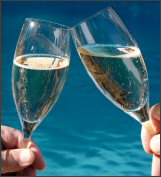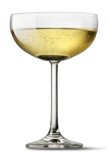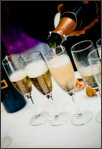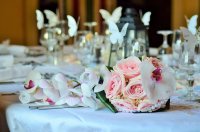Toast tips
Here are some toast tips to keep in mind when it's your turn to offer a toast at a celebration.

Be yourself
If you in the league of a Saturday Night Live host, you'd make big money whenever you talk. But even if you don't have the charisma of a TV superstar and don't know how to toast, you can still be engaging and have an impact.
Special occasions are events of the heart and call for remarks that tell how you feel about the person being honored.
Remember, only you can say something unique about your relationship.
Practice your toast
This toast tip is the best safeguard against rambling – the unforgivable sin of toasting. Write out your toast. After you are familiar with it, rehearse in front of someone to get their feedback. Or, failing that, talk to your mirror or set up a video on your phone to help. Never assume that you can be spontaneous and the right words will just happen to flow out. They probably won't. People who don't follow this toast tip too often make fools out of themselves.
Remember your audience
Save the risqué remarks for the young, hip crowd. In gatherings that include children or senior citizens, keep it clean. Heed this toast tip: taste is relative so if you're in doubt about whether certain remarks or stories are appropriate, trust your gut. You won't endear yourself to an audience that finds your remarks offensive. Leave the raunchy comments for another time.
Humor is great...but
Don't force yourself to be a comedian if that's not your talent. The best toasts feel natural. Humor is a matter of timing, build-up and surprise and, for most of us, is not a gift we have received. So practice. A funny master of ceremonies is unforgettable. But if you make a toast with humor that misses the mark, you'll be embarrassed.
Use personal stories.
Toasts are the perfect opportunity to tell a story that reveals something about the person being honored. You have a unique perspective because of experiences you have shared with this special individual. Recall one or two moments that highlight your relationship or the honoree's character in a way that relates to the special occasion.
Plan your remarks.
There is nothing worse than a rambling speaker. Don't make people start looking at their phones or watches.
While you don’t have to recite from memory, you must pay attention to the time. Depending on the event and the number of toasters, your remarks may be as short as 30 seconds or up to a few minutes. The fewer the people making toasts, the more time you can use with your own remarks.
Tributes can last longer.
If you are at an event honoring someone, your tribute may last up to five minutes. One important toast tip -- find out ahead of time how many others will be involved in giving testimonials and follow the rule that the more speakers, the less time you should spend talking.
Study the seating chart.
Know where friends and family are seated so you can make eye contact with them and get some moral support. They will boost your confidence when you make a toast.
Watch that alcohol.
Staying well under your limit is really important at an occasion where numerous toasts are given. Drinking may make you feel more relaxed but it can also impair your ability to speak clearly and your judgment about appropriate behavior.
Keep your tone chatty, funny and/or emotional and your timing short.
More toast tips
Before the toasting begins. . .
Be sure everyone has something to toast with. At a cocktail party, ask the waiters to come around and refill glasses when you are ready for the toasting to begin. At a seated dinner, you may want to have Champagne waiting at the tables if you want to begin the evening with toasts. If the toasting will take place later in the meal, let the waiters know when it is time to serve or pour the champagne.
It’s perfectly appropriate to make toast with a beverage besides champagne including non-alcoholic drinks. In fact, you should always have a non-alcoholic alternative available for those who choose not to drink.
It's time to toast
Now that you know how to toast, get everyone’s attention by tapping on the glass with your dinner knife. If that doesn't work, stand up and announce that the toasting is about to begin, asking for everybody’s attention…repeatedly if you have to. You don't have to have complete silence to make a toast but wait patiently for the noise level to drop.
Another point of toasting etiquette . . .
If you are the one being toasted, don't even pick up your glass while others are toasting you. Just say Thank you after they've finished. Hold your drink till later.
.
Champagne. . . the queen of toasting beverages
Champagne was not invented by Monk Dom Perignon but his name is the one most associated with the emergence of the sparkling wine back in the 1700s. He was not afraid to experiment and ignore the rules set by conventional winemakers and thus gave us a delightful beverage that is associated with the most elegant of celebrations.
The only beverages that can legitimately be called Champagne are those from the Champagne region of France. Bubbling alcoholic beverages from other places are considered sparkling wines.

The preferred glass for serving champagne is called a flute and is deep and narrow like those in the photo on the left.
Connoisseurs advise against serving champagne in wide-rimmed glasses as that will cause the bubbles to dissipate more quickly. But that advice is often ignored.

Traditional toasting glasses at weddings and other large gatherings are often shallow with wide rims as is the case with the glass pictured to the right. Such glasses, which are easier to hold, also have the advantage of making the champagne go further at festive occasions.
When the toast is given
Raise your glass in response to the toast. It is also traditional for those near each other to clink their glasses before taking a sip of Champagne. But don't link the rims or you risk breaking or weakening the edge of the glass. And don't finish off your drink with one toast until you are sure that no others will follow.
Why do we clink glasses?
As is usually the case, there's a story about the origin of this tradition. The Cliff Notes version is that we clink glasses before taking a slip as a show of unity. It's the outgrowth of an earlier time when people used to drink from the same vessel. Contrary to popular opinion, clinking glasses is not a tradition to ward off evil spirits.
How much will you need?
The average champagne bottle (.75 liter) pours about six glasses.
The 1.5 liter bottle will fill 12 glasses.
The 3 liter bottle will fill 24 glasses.
How to give champagne a special touch:
Add a sugar cube and dash of bitters for a traditional cocktail.
Add orange juice for a mimosa.
Add a shot of creme de menthe for an Irish-green drink.
Add passion fruit or peach nectar for a champagne cocktail.
Add peach juice or nectar for a Bellini.
Add berries or a cherry for a splash of color.
Non-alcoholic options for toasting:
Sparkling water
Sparkling cider
Water or any other beverage.

